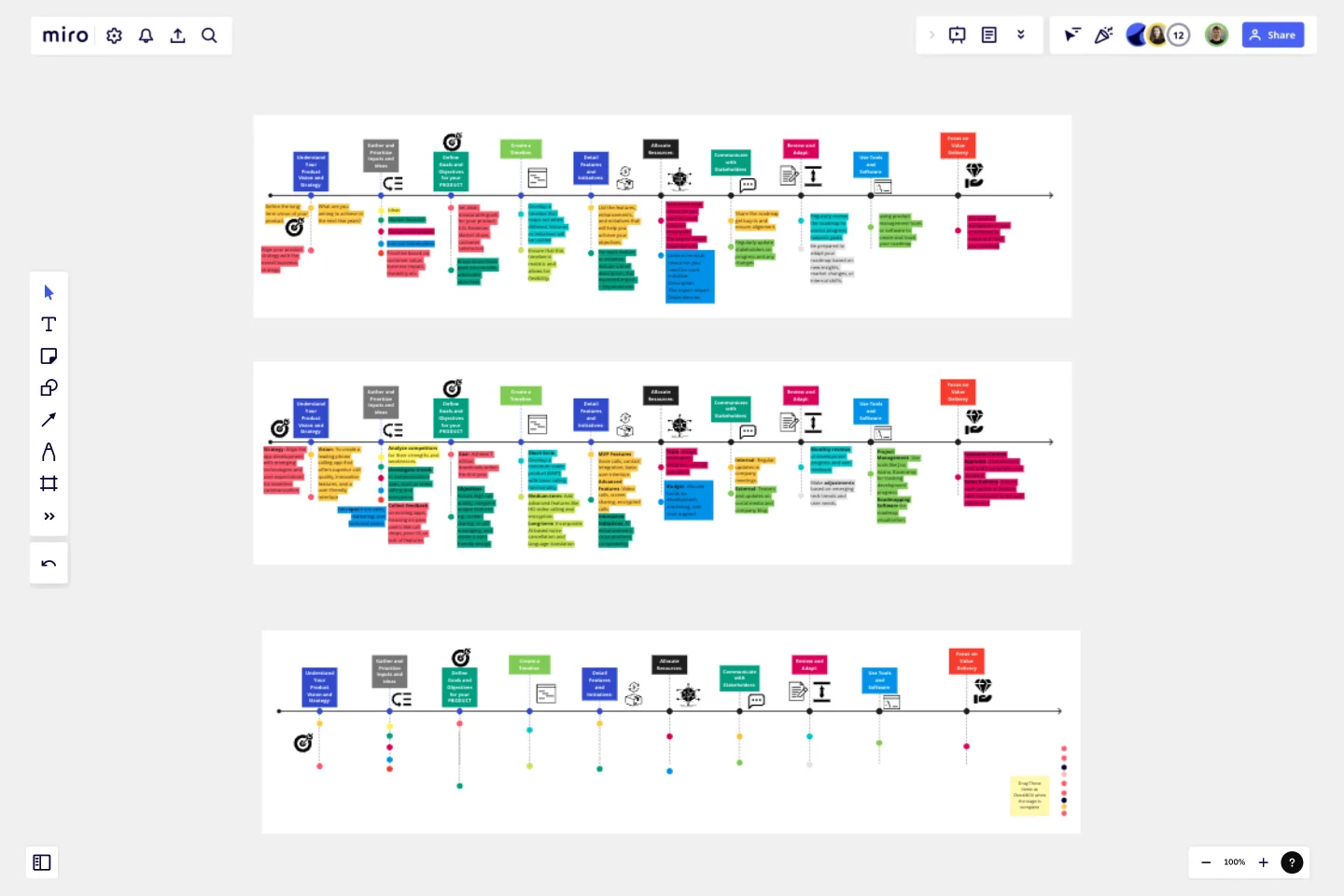Product Roadmap by Mark V. Smetanin
Blueprint to Success: Mastering Product Roadmap.
This framework guides product managers through the systematic process of creating an effective and adaptable product roadmap, ensuring alignment with business goals and market dynamics.
Creating a product roadmap as a product manager involves several key steps. Here's a general guide to help you through the process:
Understand Your Product Vision and Strategy:
Define the long-term vision of your product. What are you aiming to achieve in the next few years?
Align your product strategy with the overall business strategy. Understand how your product contributes to the broader goals of the company.
Gather and Prioritize Inputs:
Collect insights from various sources like market research, customer feedback, competitive analysis, and internal stakeholders.
Prioritize these inputs based on factors like customer value, business impact, feasibility, and alignment with your product vision.
Define Goals and Objectives:
Set clear, measurable goals for your product. These could be related to revenue, market share, customer satisfaction, etc.
Break down these goals into smaller, achievable objectives.
Create a Timeline:
Develop a timeline that maps out when different features or initiatives will be tackled. This includes short-term, medium-term, and long-term plans.
Ensure that this timeline is realistic and allows for flexibility.
Detail Features and Initiatives:
List the features, enhancements, and initiatives that will help you achieve your objectives.
For each feature or initiative, include a brief description, the expected impact, and any dependencies.
Allocate Resources:
Determine what resources (team members, budget, technology, etc.) are needed for each initiative.
Plan for resource allocation keeping in mind the capacity of your team and budget constraints.
Communicate with Stakeholders:
Share the roadmap with internal stakeholders (teams, executives) to get buy-in and ensure alignment.
Regularly update stakeholders on progress and any changes to the roadmap.
Review and Adapt:
Regularly review the roadmap to assess progress towards goals.
Be prepared to adapt your roadmap based on new insights, market changes, or internal shifts.
Use Tools and Software:
Consider using product management tools or software to create and track your roadmap. Tools like Aha!, ProductPlan, or Roadmunk can be useful.
Focus on Value Delivery:
Always keep the focus on delivering value to customers and the business.
Be open to feedback and iterate on your product based on real-world usage and changing needs.
This template was created by Mark V. Smetanin.
Get started with this template right now.
Product Vision Template
Works best for:
Product Management
Bring value to your users and develop better products using this Product Vision Template. Help teams craft a killer product vision statement and improve your business and customer experience.
Retrospective
Works best for:
Retrospective, Agile Methodology, Meetings
The Retrospective template offers a versatile and adaptable framework for teams to reflect on their performance and processes. It provides elements for sharing feedback, identifying lessons learned, and brainstorming improvements. This template enables teams to foster open communication, identify opportunities for growth, and enhance collaboration. By promoting reflection and transparency, the Retrospective empowers teams to continuously learn and evolve, driving greater efficiency and effectiveness in their work.
BCG Matrix Template
Works best for:
Strategic Planning
Use the BCG matrix template to make informed and strategic decisions about growth opportunities for your business. Assign your portfolio of products to different areas within the matrix (cash cows, dogs, question marks, stars) to prioritize where you should invest your time and money to see the best results.
Outcome Mapping Template
Works best for:
Diagrams, Mapping, Project Management
Use Miro’s outcome mapping template to improve your operational efficiency. Outcome mapping will help you visualize all the possible strategic outcomes for your upcoming project, allowing you to see into the black box to identify any potential challenges along the way.
Product Feature Presentation
Works best for:
Product Management, Planning
The Product Feature Presentation template aids product teams in showcasing product features and benefits effectively. By providing a structured framework for presenting key features, use cases, and value propositions, this template enables teams to communicate product functionality clearly and persuasively. With sections for creating feature demos, customer testimonials, and competitive differentiators, it facilitates engaging presentations that resonate with target audiences. This template serves as a powerful tool for driving product adoption and generating customer interest.
Reflection Island: End of Year Team Retro
Works best for:
Retrospectives, Agile Methodology, Meetings
The Reflection Island: End of Year Team Retro template offers a creative and themed approach to retrospectives, perfect for wrapping up the year. It provides elements for reflecting on achievements, challenges, and goals using a tropical island theme. This template enables teams to celebrate successes, learn from setbacks, and set intentions for the upcoming year in a relaxed and enjoyable atmosphere. By promoting reflection and celebration, the Reflection Island: End of Year Team Retro empowers teams to strengthen bonds, boost morale, and start the new year with renewed energy and focus effectively.
